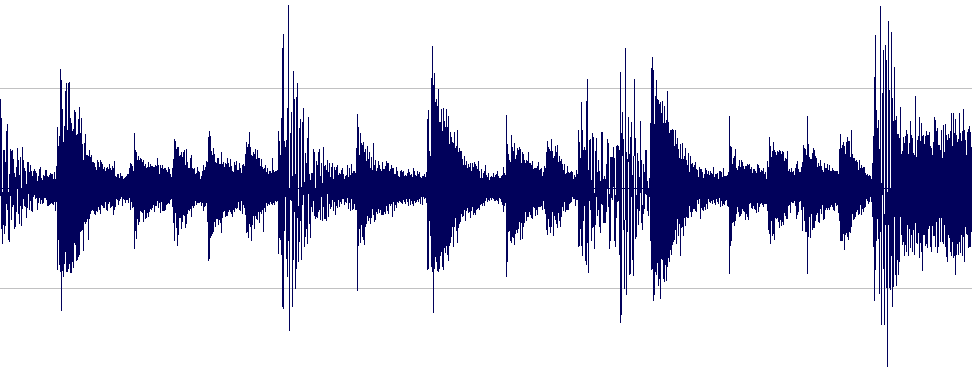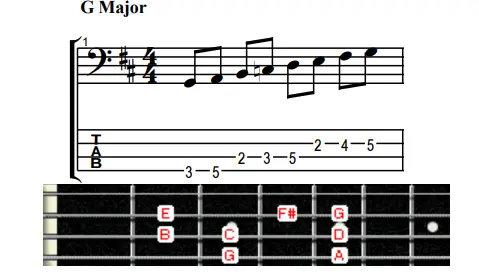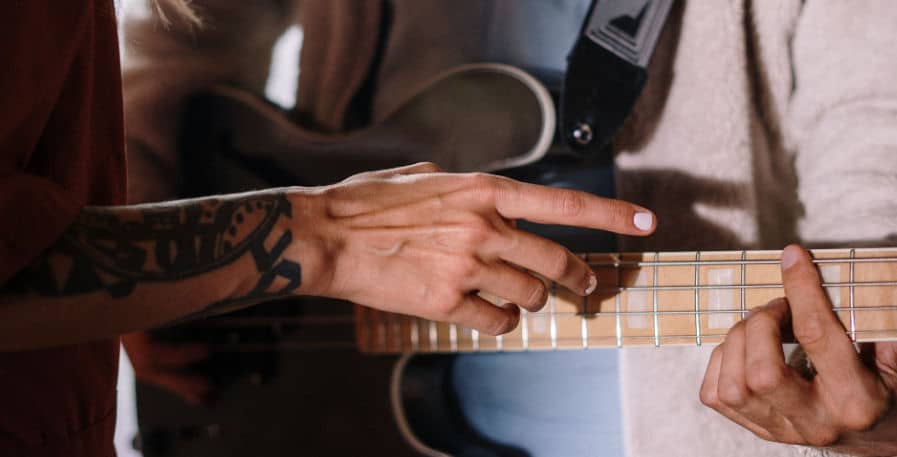How you structure your practice routines as a bass player has a gigantic impact on how quickly you improve at your instrument.
However, despite routines being such a crucial part of learning the bass, it is often paid little attention to. Oftentimes, bassists are willing to practice but don`t put much effort into thinking about what the best way to practice actually is.
Admittedly, I was guilty of this too when starting out, as I just jumped right into trying to cover songs that were way too difficult. While this held me back for a long time, I`ve since learned from my mistakes in the 15 years I`ve been playing the bass.
Therefore, I`ve written this article to share my best tips for optimizing your bass practice routines.
This way, you can avoid making the same mistakes I did and instead optimize the way you practice the bass. As a result, you will be able to change the rate at which you improve your instrument, and avoid wasting time on suboptimal exercises.
1. Foucs on What`s Important
What exercises you include in your practice sessions has a massive impact on How long it will take you to learn the bass guitar. Thus, it is crucial that you get this part right.
The list below consists of exercises that I consider to be essential to all bass players regardless of genre. This means you will benefit from making them a regular and consistent part of your practice sessions. I advise against skipping any of these, especially so if you are just starting out.
| Exercise: | Useful for: |
| Playing Scales | Learning the fretboard, introducing you to music theory, improving finger dexterity, and warming up. |
| Finger Dexterity Exercises | Developing the control of your fretting hand, smoother transitions between notes, playing faster, and making the bass less cumbersome to play. |
| Articulation exercises | Developing control of your plucking hand, and playing with feel & emotion. |
| Practicing Arpeggios | Developing control of both hands. Becoming familiar with common melodic patterns and developing your understanding of music theory. |
| Rhythmic exercises | Playing in time and staying in the pocket. Sounding tighter and developing the control of your plucking hand. |
| Speed Exercises | Improves your ability to play with control at all tempos. Increases the max speed at which you can play the bass. |
Related Reading: To see some examples, check out my guide on Beginner bass exercises
Moving on, there are also some non-essential exercises that are still useful to include in your practice routines.
For the most part, these are more genre-dependent. Practicing tapping might for example make sense for a tech-death bassist, but less so if you play in a country band. Similarly, you might put less emphasis on learning music theory if you play punk-rock than if you play jazz.
Therefore, these exercises are useful but rarely crucial to learn. I recommend incorporating these exercises occasionally, and only doing them more often if they align with your personal goals.
| Exercise: | Useful for: |
| Playing Covers | Applying what you`ve learned, learning new ways to play the bass, staying motivated |
| Learning Music Theory | Understanding your instrument, writing bass lines and songs, playing in a band, and working as a professional bassist |
| Composing | Learning to write bass lines, adding value to a band, developing your creativity |
| Moving while playing / Not looking at your hands | Better live performances, improved stage presence, better control of the bass guitar |
| Advanced techniques (i.e Tapping, Harmonics, Sweep picking) | Technical proficiency, playing specific songs, advanced mastery of the instrument |
2. Experiment
Despite there being some essential exercises, there is no all-encapsulating practice schedule that works for every bass player. This is because people have different lifestyles, time constraints, personalities, goals, and genre preferences.
Therefore, when crafting a practice schedule it is crucial that you experiment with what works for you. Also, you will be better off by constantly evaluating and adjusting your schedule as your skill level, needs and preferences change.
To get some ideas on how to do this, here are some suggestions on how to change up your practice sessions:
- Change up what time of day you practice at
- Split a long session into 2 short ones, or two short sessions into 1 long session.
- Try new exercises
- Look for alternate ways to play old exercises
- Focus more on theory and educational content than playing
- Learn to jam on the bass instead of following a rigid schedule
- Force yourself to play using just one string.
- Force yourself to play a bass line using all 4 strings.
- Force yourself to play using only the 4 deepest frets.
- Force yourself to only play above the 12th fret.
Some of these suggestions will suit you, while others will not. Regardless, they will all lead you toward finding the perfect schedule for you or expand your understanding of the bass.

3. Keep A Practice Journal
It took me about a decade of playing the bass before I started tracking my practice sessions. Long story short, I am never going back.
I say this because tracking your practice sessions is the best way to see what exercises actually lead to improvement. Seeing my progress written out has also helped me to stay motivated and consistent.
Here`s what I typically add in a journal entry of my practice sessions:
- What exercises I did (i.e: Scales for warm-up, Dexterity exercises)
- How long I did do them for (i.e: Warm up: 5min, Dexterity exercises: 15min)
- Changes from the last practice sessions (i.e Slight increase in speed, better control of fretting hand)
- Things to focus on next time (i.e Focus more on articulating notes well, don`t rush through exercises)
- General Notes about the sessions (i.e Practice earlier during the day, don`t practice during a caffeine crash)
These are the points that I`ve found to be the most important through the years. I recommend starting with these points if you have never journaled before.
As you develop a habit of tracking practice sessions, you might find it suitable to remove some points and add others. You might for example want to track your max speed from session to session, or record yourself when as you play.
As for how to journal, I personally have a folder where I track each session using Samsung Notes. You can also use Notes for iOS, or 3rd party software like Notion or Evernote. These are available for iOS, Android, and Desktop. Alternatively, you can also opt for a physical journal if you want something more tactile.
4. Practice Your Articulation
Dynamic plucking, or articulation, means to play notes with varying intensity. When done well, this can make your bass lines sound more lively and human. Articulation can also be used to play softer at a tranquil part of a song, or more intensely during crescendos.
Dynamics is often the difference between a good and an amazing bass player. It`s also a big part of why the bass guitar is hard to learn at a high level. This is why I believe articulation should be a staple part of your bass practice routine.
Here are the two main ways to practice it:
- Exercise 1: Pluck notes as consistently as you can
- Exercise 2: Gradually go from playing notes as softly as you can to as intensely as you can and back again.
A great way to hear how well you articulate notes is to record yourself.
Even better, you can look at the waveform of your recordings, and see whether they remain constant or differ in intensity. For exercise 1, it should look consistent, for exercise 2 you should see an equal rise and an equal decline in intensity.

Lastly, it`s helpful to listen to dynamic bass lines for inspiration.
One of the best examples of this is Marcus Miller`s Power. I recommend listening to it below and paying attention to how vital and lively the track sounds as a result of how he articulates notes differently.
5. Master New Scales
Scales are the bread and butter of playing the bass guitar.
For those less interested in theory, it can be enough to memorize the patterns that make up certain scales. If you want to take a more theoretical approach, the more scales you master, the better your foundational knowledge will be.
I believe that there are some essential scales all bassists should memorize. Thus, if you do not yet know the following scales, make sure to incorporate learning these 5 into your practice routine:
- Minor Scale
- Minor Pentatonic
- Major Scale
- Major Pentatonic
- The Blues Scale

However, you should not stop there once you master these 5 scales.
Moving forward, I recommend focusing on learning scales that are common for your genre. For example, if you play jazz, focus on learning the most common jazz bass scales.
These scales will be vastly different from the scales metal bassists use, as they are used in completely different musical contexts. Thus, by taking this type of genre-specific approach, you will get the most out of learning and practicing scales.

6. Get Feedback
“A mentor is someone who sees more talent and ability within you, than you see in yourself, and helps bring it out of you.”
Bob Proctor – New-York Times Best-Selling Self-Help Author
Regardless of what you are trying to improve at, getting feedback is invaluable. This holds especially true as a bass player because there is so much that goes into playing this instrument well.
Maybe you are able to play fast, but the clarity of your notes is suffering. Or if you are able to play notes clearly, they might still sound bad because you don`t know how to set your tone. If your tone sounds great, your plucking technique could be of which could ruin your stamina.
It is extremely difficult to get all of this right on your own. Sometimes, all you need is a new set of eyes and ears to avoid building horrible habits that you will need to fix later.
Therefore, regularly get feedback on your playing.
The best way to do this is by taking lessons, either in person or online. Alternatively, if you are part of a music community, experienced musicians are often happy to help you and give some feedback on your playing if you ask.
You can also upload videos of yourself, and request feedback on Youtube, Reddit, or Drooble. The upside of this is that people will generally be honest, though this can also result in some comments coming off as overly harsh.
7. Keep It Fun
Chances are that having fun isn`t the first thing on your mind if you are looking for the optimal way to improve as a bassist.
However, I believe that playing the bass should not feel tedious or boring, even when optimizing for improvement. With that said, I have to admit that playing scales and exercises day after day is not the most entertaining thing in the world.
This in turn can result in you feeling unmotivated to play, and in time giving up on the instrument. As this is the worst-case scenario, the optimal thing is to ensure that playing the bass remains fun for you.
A good way to do this, while still getting a lot out of your practice sessions, is to play cover songs. This way, you can improve at the bass in a non-tedious way while engaging with your favorite music at the same time.
Related reading: Easy bass tabs for beginners
Learning songs is, admittedly, not the best way for building speed or developing your technique. Instead, it is a way to keep things fresh while learning about the different ways the bass can be played.
Other ways to keep playing the bass fun are:
- Add Variety – Change up what exercises you do
- Rest – Take a break (I`ve found that 2-3 days off works well for me to rejuvenate my love for the bass)
- Play with other people
- Free Play – Put on a metronome or backing track and just play the first thing that comes to your head.
- Write a bass line – Apply what you have learned so far by writing a bass that makes use of your knowledge and skills.
- Watch & Listen – Listen to or watch videos of great bass players to emulate their technique and to get inspired.

8. Use The Pomodoro Technique
The Pomodoro technique is a simple time-management and concentration method. You simply put on a timer, practice for a set amount of time, and then take a short break.
A common split is 25 minutes of practice and 5 minutes of rest. This is however merely a starting point, and you can prolong or shorten either the practice or rest timer as you see fit.
I started out with the common 25-5 split, but have later gravitated towards a split of 40 minutes of practice, and 10 minutes of rest. This is about how long I can stay focused while playing, and 10 minutes makes for a break that feels long enough without wasting time.
In a 2010 paper by Xiaofeng Wang, he shows how the Pomodoro technique has shown various benefits in turning time from an enemy into an ally. Thus, if you struggle to make time for practicing the bass, or to stay focused while practicing, you might find this method helpful. technique helpful.
9. Consume Educational Content
There is no better time to learn the bass guitar than right now. This is because there is a sea of free content that you can learn online.
I highly recommend making the best possible use of these tools that you possibly can. Personally, I am a big fan of doing some reading or watching some videos after I`m done playing for the day.
Then, even though my hands are tired of the bass, my mind isn`t. This makes it prime time to consume some helpful content and continue improving despite putting my bass down.
With this in mind, here is a list of some of the best free available resources for learning the bass online:
- Bassox – My website has tons of content about learning the bass, being a bass player, and the technical aspects of the bass guitar. If you prefer written content that is based on genuine experiences, there is a lot more to uncover on this blog.
- StudyBass – Another written resource, Studybass takes a more theoretical approach to learn the bass. Andrew Pouska has a clear and concise writing style that focuses on the stuff that truly matters for improvement. I recommend this site if you know, or want to learn music theory and use this as a tool for improving as a bassist.
- Talkingbass – For video content, I recommend Talkingbass. Mark J Smith is an amazing tutor, and he makes long-form videos that will answer questions you didn`t even know you had. He also has multiple paid courses, though he has enough free content to last for a long while.
10. Focus on Finger Dexterity
Most exercises tend to at least partly serve as dexterity exercises. However, it`s helpful to incorporate some exercises that target dexterity specifically in your bass practice routines.
Exercises that target dexterity well will have both long horizontal and vertical leaps. For example, they might require you to play one note with your index finger, and then the next with your pinky. They will also leap across 1 or 2 strings at a time, requiring you to quickly move up and down the fretboard.

Since most exercises target dexterity indirectly, many practice routines don`t put enough emphasis on it.
Since it is such an important part of developing your technique though, I recommend incorporating at least one regular dexterity exercise. Feel free to use the one above, or use any kind of exercise with wide horizontal and vertical leaps.

11. Have A Practice Spot
When learning an instrument, there are several benefits of a designated practice spot.
Most notably, a set practice spot will prevent unfocused practice sessions. A lack of a designated spot can for example lead to short bursts of practice or playing the bass while watching a TV show. While this is better than nothing, it doesn`t come close to focused practice.
A set practice spot can also be helpful for avoiding distractions. By sitting down at a specific spot, you get a sense of committing yourself to practice for a certain amount of time. This makes it easier to avoid distractions and stick to your practice routine, ensuring that you get the most out of your session.
Your practice spot can either be a specific room, or a rehearsal space. If that isn`t an option, a specific corner of a room or a specific char will also do the trick. The important part is to have a spot that you don`t use for anything else; a spot where you can say “this is where I play the bass”.
12. Stay Consistent
I`ve come to realize that getting good at the bass is not a race against others, but rather a marathon against yourself.
After all, it is better to practice for 15 minutes each day, than to practice for 2 hours only to become burnt out and give up on the bass. You might also improve faster by focusing on exercises, but sometimes you need to cover songs and jam out in order to maintain your interest in the bass.
And that`s okay. The most important thing to optimize your practice schedule as a bass player is to ensure that you stick to it.
Therefore, how long to practice bass each day depends both on your goals and your personal preferences. With that in mind, here are some questions to ask yourself when you start a practice session:
- General Interest – Am I looking forward to playing the bass today? Or Am I looking forward to being done with the session?
- Particular Sessions – Am I looking to get through the sessions as quickly as possible? Or am I looking to play for as long as I can or want?
- Practice Routine – Do the things I am going to practice today excite me? Or do I find them tedious, repetitive, and boring?
This should give you an idea of how you feel about the things you are practicing, and whether you are practicing them for an appropriate amount of time. If you find your answers to be negative, it could be wise to find other ways to practice to ensure that you stay consistent going forward.
While this can seem suboptimal, this will both help you stick to playing the bass, and make the process a lot more enjoyable. Ultimately, the worst thing you can do is to give up. Thus, always do whatever you can to prevent yourself from throwing in the towel.

